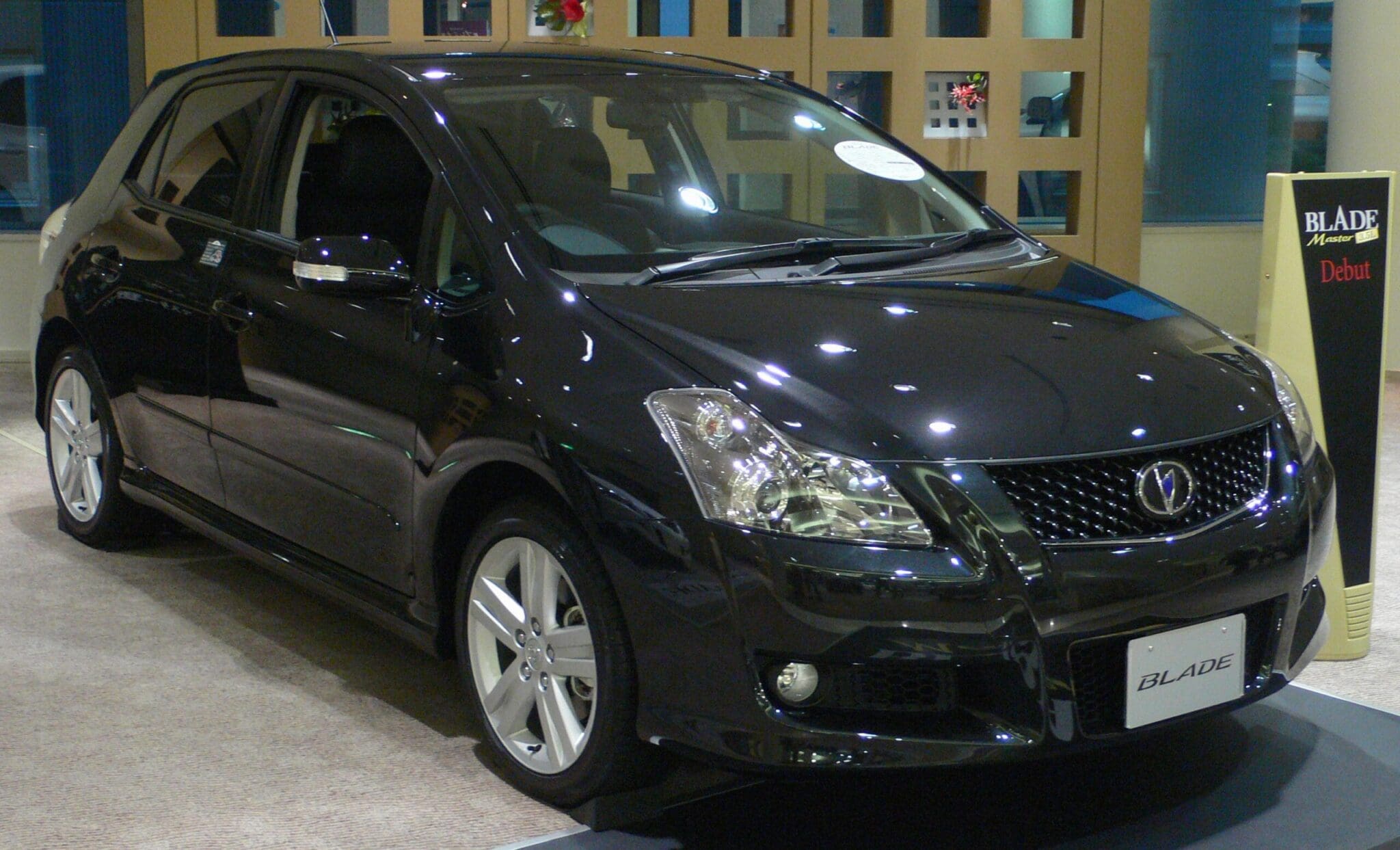Toyota is the tenth-largest automobile manufacturer in the world. Toyota was also the world’s first manufacturer to bring hybrid electric vehicles to the market, having done so in 1997. It is a global corporation established in 1937 by Kiichiro Toyoda.
It has a large number of subsidiaries and annually manufactures 10 million cars. Toyota Motors produces cars under the Lexus, Ranz, Hino, and Daihatsu brands. Toyota also produces the Blade and Auris models.
Key Takeaways
- Toyota Blade is a sports sedan, while Toyota Auris is a compact hatchback.
- Toyota Blade has a more powerful engine and a sportier design than Toyota Auris.
- Toyota Blade is more expensive than Toyota Auris.
Toyota Blade vs Auris
The Toyota Blade is a mid-size sedan that was produced from 2006 to 2012, was known for its sporty styling and performance, and was compared to the Lexus IS. The Toyota Auris is a compact hatchback that was produced from 2006 to 2018, known for its practicality and fuel efficiency.

Toyota Blade is a twin-engined variant of the Toyota Auris. 2007 was the first year that Blade was manufactured in Japan.
Head restraints, anti-lock braking system (ABS), front seatbelt pre-tensioners, airbags, side airbags, and other standard safety equipment are included.
The 2.4-litre engine is equipped with a timing chain that does not require regular replacement.
Toyota Auris means Toyota Ōrisu in Japanese, and when it was launched in 2006, it replaced the Toyota Blade.
The first generation three/five-door hatchback shared a platform with the E150 series Corolla when it was introduced in 2006, whereas the second generation five-door hatchback and station wagon, dubbed “Touring Sports,” shares a platform with the E180 series Corolla.
The name “Auris” is derived from the Latin word for “gold,” which is “aurum.”
Comparison Table
| Parameters of Comparison | Toyota Blade | Toyota Auris |
|---|---|---|
| Introduced | 2007 | 2006 |
| Body Style | 5 door hatchback | three/five-door hatchback |
| Mileage | 8.7 litres/100 km | 4.8 litres/100 km |
| Engine | 210.9 cu-in | 121.9 cu-in |
| Fuel Consumption | High-fuel consumption | Low-fuel consumption |
What is Toyota Blade?
The Toyota Blade is an ultra-compact version of the popular Corolla car. There are luxury interior finishes, extra safety features, and engines that are seen in the bigger Camry in this tiny hatchback.
This translates into higher performance and comfort-albeit at the cost of a higher initial purchase price and increased fuel consumption. It is only available as a second-hand import from Japan at this time.
Even though it is built on the regular Corolla, the Blade’s is a cut above the rest due to the use of a suede-like material on the doors and dashboard top.
The steering wheel is equipped with audio controls as well as a button for controlling the trip computer displays, which are located in the centre of the instrument pod’s circular, backlit dials. In the Blade, there are two different engines to choose from.
Standard models, like test vehicles, are powered by a 2.4-litre four-cylinder engine, while “Master” variants are equipped with a powerful 3.5-litre six-cylinder engine that is more seen in big cars and SUVs.
The 2.4-litre engine can produce 123kW and 224Nm of power, which is more than 20% higher than the power of a normal Corolla.
It is coupled with a continuously variable gearbox (CVT).his system is referred to as Vehicle Dynamic Control, or VDC, in Toyota vehicles, and it is not deactivated or turned off.
Fully extended shoulder-type belts are provided in all three places of the back seat. These belts provide greater protection than lap-only belts.
ISOFIX child seat mounts are located in the rear window seats, and there are three tether points behind the child seat mounts.

What is Toyota Auris?
The Toyota Auris hatchback has been given a new front end that looks more like the Corolla Axio to better suit the preferences of the Japanese market, and it is now available for purchase in Japan under the name Toyota Blade, which is positioned as a luxury hatchback.
The Toyota Blade for the Japanese market is powered by a 2AZ-FE 2.4-liter DOHC VVT-i engine, which is very similar to the engine in our local Toyota Camry 2.4.
That translates to 165 horsepower at 6,000 rpm and 224 Newton meters of torque at 4,000 rpm, respectively.
However, the Toyota Auris is also available for purchase in Japan, although it is positioned lower in the product line and is only available with one of two available engines: a 1.5-litre or an 18-litre.
Unlike our Camry, the Toyota Blade’s engine is paired with a Super CVT-I gearbox, which offers virtually unlimited ratios in the automatic mode.
For an average of 200-250,000 yen, you can have a Toyota Blade equipped with an all-wheel drive, which transfers all power to the front wheels as standard equipment.
Toyota expects to sell approximately 3,000 units of the Toyota Blade each month in the Japanese market, according to the manufacturer.

Main Differences Between Toyota Blade and Auris
- Toyota Blade was introduced in the year 2007, whereas Toyota Auris was introduced in the year 2006.
- Toyota Blade has a body style of a 5 door hatchback. Auris has a body style of three/five-door hatchback.
- Toyota Blade has a mileage of 8.7 litre/100km. Auris has a mileage of 4.8 litre/100 km.
- Toyota Blade has an engine of 210.9 cu-in. Auris has an engine of 121.9 cu-in.
- Toyota Auris has Low-fuel consumption. The blade has High-fuel consumption.
- https://reposit.haw-hamburg.de/handle/20.500.12738/7888
- https://link.springer.com/chapter/10.1057/9780230233591_8

Toyota’s focus on innovation and technology in the Blade and Auris models is commendable.
The safety features and the high fuel consumption comparison provide a practical insight into the performance of Toyota Blade and Toyota Auris.
The details on the Toyota Blade and Toyota Auris give a complete understanding of the characteristics of each model.
The detailed information on the Toyota Blade and Toyota Auris models is very comprehensive and useful.
It’s fascinating to see how Toyota incorporates sustainability into their production by bringing the first hybrid electric vehicles to the market back in 1997.
Absolutely, Toyota has set a high standard for other automobile manufacturers.
Indeed, Toyota’s environmental efforts are commendable.
The comparison between Toyota Blade and Toyota Auris provides valuable insights into their design and performance differences.
The comparison table provides a clear overview of the differences between Toyota Blade and Toyota Auris regarding their key parameters.
Toyota’s expansion into different car brands such as Lexus, Ranz, Hino, and Daihatsu makes it a powerhouse in the automobile industry.
The distinct features and unique positioning of the Toyota Blade and Toyota Auris demonstrate the versatility of Toyota’s product line.
The names of the Toyota models holding significance drawn from different sources is an interesting fact to delve into.